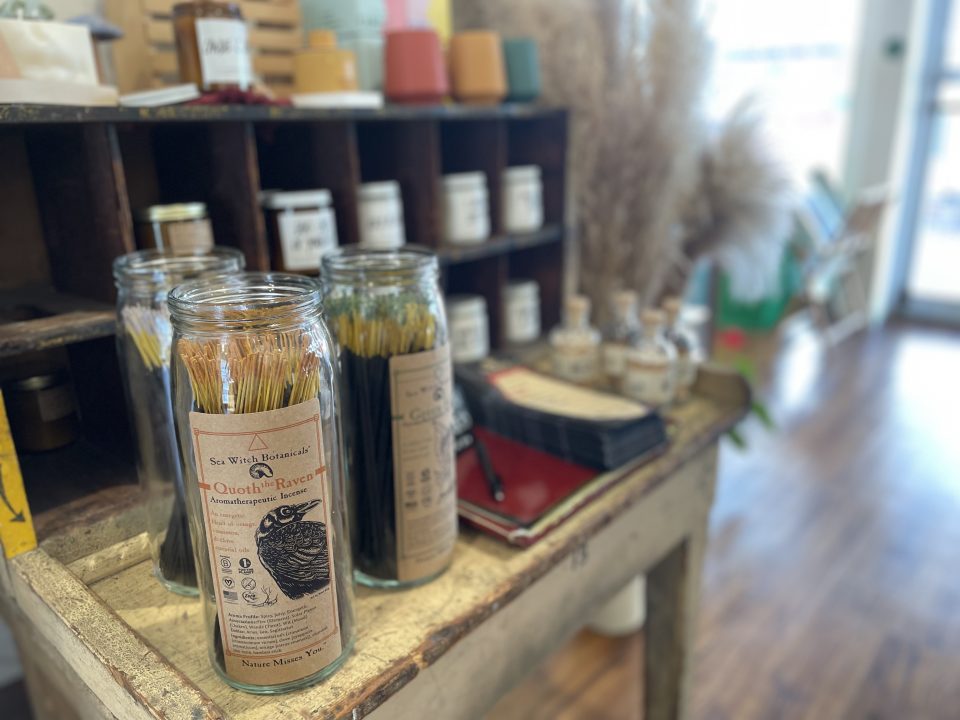
Professors and historians are among the few who know about the graves.
There are no clear demarcations around the African American burial site, and a neighboring yard seems to have swallowed it. Survey records from 1967 indicate that it’s surrounded by a nearly 3-acre swatch of Stony Brook University property, in walking distance from Long Island Rail Road tracks. The school hasn’t done anything with the land and doesn’t plan to any time soon.
At least three people are buried there: Cane (1738-1814), Anthony Hannibal Clapp (1749-1816) and Mary Brewster (c.1815-1850). Clapp’s headstone, broken at the base, was taken by the Suffolk Museum, now the Long Island Museum, in 1944. It’s an unusually ornate stone, with a fiddle carved at the top and a long epitaph inscribed underneath. The footstone is still at the grave site.
The museum took Cane’s headstone in 1949 as well. There were concerns that the grave would be vandalized or damaged by time, according to an unpublished manuscript written by curator Jonathan Olly. The museum left a small stone marker in its place.
Brewster’s grave is in pieces, but it’s still there. According to historical writer Edward Lapham, the inscription reads: “Mrs. Mary wife of Adam Brewster died Oct. 17th 1850 aged 35 years. Prepare to meet thy God.”
Shepard Alonzo Mount, who grew up on the farm that originally encompassed the grave site, immortalized the burial ground in a painting (c. 1850) now kept by the Long Island Museum. Both Clapp and Cane’s headstones stand next to each other, behind a wooden fence, bordering a green field.

Lapham recorded what the site looked like a century later in his 1942 book, “Stony Brook Secrets.” The museum hadn’t touched the headstones before the book was published.
“[The graves] are on the opposite side of the old stage-coach road in a patch of woods overgrown with brambles and poison-ivy,” he wrote. “Cane’s stone is still there but Tony’s had broken off, and I understand it is now in William Sidney’s studio on the top floor of the house.”
Homes were being built in the area when the museum took the stones with the permission of the town and local property owners, according to Olly. A local resident was concerned that the gravestones would be damaged or destroyed.
“That was fine with the ethics of the late 40s, early 50s, but today that really isn’t something a museum would do,” he added.
Both Cane and Clapp were born before the American Revolution and eventually became enslaved to the Hawkins family in Stony Brook, according to an unfinished manuscript written by Olly. Eleazer Hawkins became the first documented owner of the Hawkins-Mount house, built around 1725. His direct descendants would include local artists William and Shepard Mount.
William Sidney Mount went on to become a famous American painter, renowned for works such as “Eel Spearing at Setauket” and “Bargaining for a Horse (Farmers Beginning),” and for patenting his own type of fiddle. He described the graves in an 1853 letter to a friend (included in Olly’s manuscript):
“In wandering about the Hills the other day, I visited the burial ground, a place appropriated for the slaves (belonging to our family) [in] years gone by, on our farm, and was so much struck with the sublimity and originality of one of the monuments to a distinguished fiddler, and as my late Uncle Micah Hawkins wrote the Epitaph and placed the stone to the old negro’s memory, and as you are an advocate for musical genius, I felt it my duty to send you a copy. I have sat by Anthony when I was a child, to hear him play his jigs and hornpipes. He was a master in that way, and acted well his part.”

ENTIRELY TONE-LESS Honor and shame from no condition rise Act well thy part, there all honor lies *** ANTHONY HANNIBAL CLAPP Of African descent. Born at Horseneck Conn, 14, July 1749 came to Setauket in 1779, Here sojourning until he died 12, Oct. 1816 ˉˉ*ˉˉ Anthony, though indigent, was most content, Though of a race despis’d, deserv’d he much respect – in his deportment modest and polite, Forever faithfully performing in life’s drama the eccentrick part assign’d him by his Maker. His philosophy agreed with his example to be happy Himself, and to make others so, being selfish, but in the coveting from his acquaintance an undivided approbation, which he was so Fortunate as to obtain and keep – Upon the Violin, few play’d as Toney play’d, His artless music was a language universal, and in its Effect – most Irresistible! Ay, and was he not of Setauket’s dancing Steps a Physiognomist, indeed; he was. – Nor old nor young, of either sex, stood on The Floor to Jig-it, but he knew the gait. Peculiar of their Hobby, and unasked, Plac’d his best foot foremost for them, by his Fiddle. ―.― This Emblamatick Lachrymatory, and Cenotaph’s, the grateful tribute of a few of either sex who knew his worth. ―.― P. Hill. Carver.
Left: headstone with epitaph of Anthony Hannibal Clapp. Right: transcription of the epitaph on Clapp’s headstone. COURTESY OF THE LONG ISLAND MUSEUM
Clapp is well remembered by historians as a popular fiddle player. His tombstone describes his music as a “language universal” with an effect “most irresistible.”
Such a detailed headstone was “really unusual,” Olly said, noting that it would have been “extremely expensive.” He acknowledged that it’s possible the family’s motivations were “self-serving;” the Hawkins might have wanted to demonstrate that they were “very kind and generous to their former servants” who passed away.
Olly wrote in his manuscript that Clapp’s headstone was “carved and signed by noted Connecticut-born stone cutter Phineas Hill (1778-1844) of Huntington,” and though the Hawkins house stopped using enslaved labor after the 1810s, both graves are noteworthy because “the family took the unusual step of memorializing two of the people whom they once enslaved.”
Almost nothing is known about Cane. He was one of the last people enslaved by the Hawkins family, and it’s unlikely he was free when he died at 77. There’s a built-in bench next to the fireplace in the Hawkins-Mount house called “Cane’s seat,” but it’s not certain why.
“It’s possible that Cane built it, frequently sat there as an elderly man, or both,” Olly mused in his manuscript.
Cane’s grave was marked with a large tombstone and his epitaph was written by family friend Ruth Smith of Setauket, according to Olly’s manuscript.

Beneath this stone was put the mortal part of CANE, a colour’d person. He was born the 27th of Dec’r 1738 and died the 12th of Jan’y 1814. in the 77th year of his age. CANE was an honest man. Tho nature ting’d his skin and custom mark’d Him “Slave”! his mind Was fair, free and independant. His life, all through, was such as did command Esteem, from those who knew him and In death, he shew’d examples of Religion, full Convincing of his christian faith, That his Redeemer liv’d And he should see his face.
Left: headstone and epitaph of Cane from a photograph taken in 1949. Right: transcription of the epitaph on Cane’s headstone. COURTESY OF THE LONG ISLAND MUSEUM
Mary Brewster was likely not enslaved, though if her mother was it’s possible Brewster was indentured to her enslavers. It is not clear what connection she had to the Hawkins-Mount family. Census records show that Mary Brewster lived in Smithtown with her husband Adam Brewster (1816-1885) in 1850. Mary died at 35, only two months after the census was taken, and Adam remarried shortly after.
Olly pointed out that since all were buried during and after the end of slavery in New York, which legally ended in 1827, Brewster’s grave shows that people of African descent were using the land as a burial ground into the mid-1800s.
“I’d guess there are more graves in the vicinity that are unmarked, given William Sidney Mount’s description of the site in an 1853 letter as ‘the burial ground, a place appropriated for the slaves (belonging to our family) [in] years gone by – on our farm,’” Olly wrote in an email.
Graves for people of African descent were identified in a variety of ways, often with temporary markers. If not marked with a wooden or stone slab, graves were honored with plants such as cedar trees or yuccas, wooden staffs — thought to perhaps have religious or spiritual significance — and pieces of iron pipe, railroad iron, shells or other objects.
Older cemeteries with enslaved individuals were rarely documented.
Construction of a federal office building in Manhattan was halted in 1991 after bones were discovered several feet down. A little more than 400 bodies were ultimately uncovered, although it’s estimated that the total number of free and enslaved African Americans buried there ranges between 10,000 and 20,000.
“Among the scars left by the heritage of slavery, one of the greatest is an absence: where are the memorials, cemeteries, architectural structures or sturdy sanctuaries that typically provide the ground for a people’s memory?” journalist Edward Rothstein wrote in the New York Times.
When Olly visited the Stony Brook site in April 2016, an adjacent homeowner told him that “either he or his father found the toppled headstone and footstones while clearing brush and moved them to the base of a large tree to prevent further damage.”
Olly doesn’t know if the 1949 marker placed by the Long Island Museum is in the same spot where Cane’s original headstone was removed, but he thinks it’s likely.
“Hopefully at some point the boundaries of the cemetery can be determined and marked,” he wrote in an email.

Mary Brewster’s footstone. BRIANNE LEDDA/THE STATESMAN 
Mary Brewster’s headstone. BRIANNE LEDDA/THE STATESMAN 
Mary Brewster’s headstone and two footstones. BRIANNE LEDDA/THE STATESMAN 
Jonathan Olly, curator at the Long Island Museum, brushes dirt off a footstone. BRIANNE LEDDA/THE STATESMAN 
Mary Brewster’s tombstone is broken in pieces. COURTESY OF THE LONG ISLAND MUSEUM 
A footstone. BRIANNE LEDDA/THE STATESMAN 
The graves are near Old Colonial Road. BRIANNE LEDDA/THE STATESMAN 
Cane’s marker is surrounded by brush. BRIANNE LEDDA/THE STATESMAN 
The gravel path leading to the graves. BRIANNE LEDDA/THE STATESMAN
































Mary V Archdeacon • Sep 23, 2020 at 8:52 pm
I luv on Dogwood Dr Stony Brook. While taking a walk a couple of weeks ago With my dog, Penny I Found Cane’s gravestone which I had first heard of in my father in laws John Spencer Archdeacon’s autobiography I’d love to know where the broken piece of gravestone of Anthony Hannibal Clapp is by Canes gravestone.